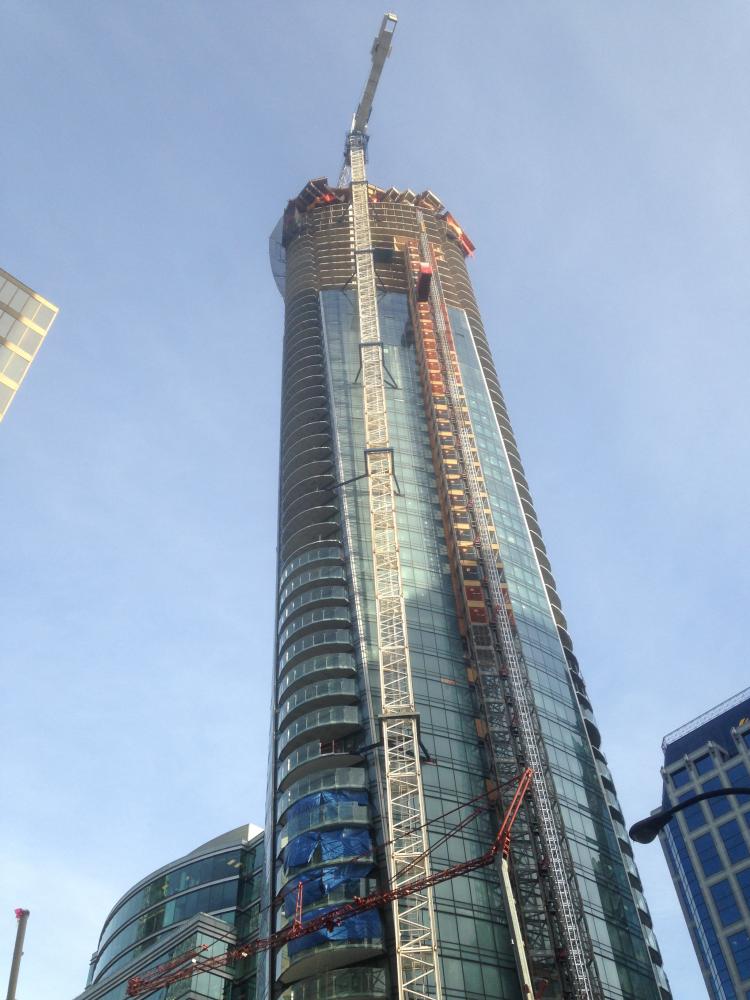The new Trump International Hotel & Tower in Vancouver, British Columbia, is an impressive structure.
Scheduled to open in 2016, the 63-story, twisting luxury tower made of glass and steel will hold 218 homes, 147 hotel rooms, and 15,000 sq. ft. of event space, as well as spas, bars, and high-end restaurants.
One challenge for the contractors on the iconic building project was how to assemble a steel canopy piece by piece at up to 70-ft. above the street between two high-rise buildings.
A tower crane used to build the main structure of Trump Tower was already working at full utilization, so it could not place the steel for the canopy.
A mobile crane would have had the reach and capacity to handle the job, except that the only place to set one up would have been on a busy street that the city would not allow to be blocked. Also, the sidewalk could not be blocked for more than a few hours at a time because of heavy pedestrian traffic and the need for customers to get to local shops.
The project needed some way to place the steel for the canopy without blocking the street or sidewalk.
Bringing the solution
Enter Bigfoot Crane Company Inc., a relatively new crane sales and rental company from Abbotsford, British Columbia. Bigfoot was formed last year by crane experts who bought the self-erecting crane, full-sized tower crane, and training portions of Eagle West Cranes. (TNT Crane & Rigging, Houston, Texas, bought Eagle West’s knuckleboom and hydraulic all-terrain cranes.)
Bigfoot rents and sells self-erecting, tower, and city cranes throughout western Canada. Its rental fleet numbers about 50 units. Bigfoot also rents and sells under-hook accessories, and it is a dealer for Boscaro accessories and San Marco self-erecting cranes.
Bigfoot Managing Director Ryan Burton suggested that the contractors on the Trump building place a Potain HD40A self-erecting crane atop a 20-ft. engineered platform to pick and place the steel canopy sections. The platform would put the crane in position to make the required lifts while keeping the sidewalk and street clear.
The contractors leased both the crane and the engineered platform from Bigfoot for two to three months to do the job.
“We had the platform, which had proven itself on three previous jobs. We also have 10-ft. and 15-ft. models,” Burton said. “It seemed like a perfect fit for this project. The pedestrians simply walk beneath the crane.”
Bigfoot set up the elevated platform in just six hours with a 28-ton boom truck and 60-ton rear-mounted knuckleboom crane.
A couple of weeks later, a 200-ton crane set the Potain HD40A self-erector on the platform, and a 33-ton knuckleboom crane stacked the Potain’s 60,000 lbs. of counterweight. Bigfoot needed just six hours to spot the crane, stack its counterweights, and erect it for use.
The Potain HD40A measures 85'11" from its base to the top of its boom support and has 13'9" x 13'9" footprint. On this project, it was rigged with a 115 ft. of boom and had a capacity range from 8,188 lbs. at the shortest radius to 2,200 lbs. at the boom tip.
Production plus safety
Burton estimates that during the three-month rental, the HD40A set some 200 pieces of canopy ranging from 250 lbs. and 10 ft. long to nearly 8,000 lbs. and 50 ft. long. It also handled glass, roofing, and many other materials to and from the work site.
“This crane has a hydraulic unfolding jib, so the contractor can fold and unfold the jib as needed during the project,” Burton said. “When the jib is folded back, the crane can swing over the street and offload the steel, then swing it to a staging site. Once the steel is staged, the operator can unfold the jib to place pieces in final position for the crews to bolt in.”
Burton explained that for this job, the crane was rented bare, and the contractor supplied its own operator. “The operator is running the crane by remote control,” Burton said. “He’s standing right where the canopy sections are being placed and bolted in.”
A safe-work procedure and radio contact between the operator of the Potain HD40A and the tower crane working near the top of the building let both cranes lift materials off of trucks in the street-side unloading zone without the Potain hitting the taller crane’s load line.
Because there is not room on the jobsite for the Potain to weathervane when it is not being used, Bigfoot engineered a tie-down procedure that secures the crane’s jib in place when the crane is out of service.
In addition to selling and renting equipment, Bigfoot also can provide crane and rigging training on most types of cranes in western Canada. It also offers mobilization, repair, and maintenance services for cranes owned by other companies.

